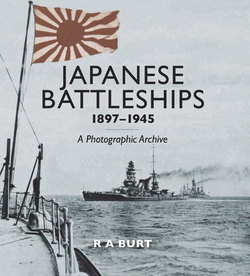Читать книгу Japanese Battleships, 1897?1945 - R. A. Burt - Страница 11
ОглавлениеDisplacement: 9,773 tons normal load
Dimensions: Length: 435ft oa; Beam: 68ft 7in; Draught: 24ft 4in mean
Armament: 4 × 8in 40cal; 14 × 6in 40cal; 12 × 12pdr; 8 × 47mm; TT: 5 × 18in
Armour: Main belt: 7in–3½in; Barbettes: 6in; Turrets: 6in (faces); Decks: 2½in–1¼in; Conning tower: 14in
Machinery: Two sets four-cylinder, triple-expansion engines driving two screws, twenty-four Belleville boilers
Designed SHP: 14,500 for 20 knots
Fuel: 600 tons coal normal, 1,402 tons max
Complement: 483
Laid down: 1898, Armstrong, Elswick
Launched: 19 September 1899
Completed: September 1900
Fate: Sunk by US aircraft at Kure, 28 July 1945
Laid down: 1899, Armstrong’s, Elswick
Launched: 29 March 1900
Completed: March 1901
Fate: Sunk by US aircraft at Kure, 24 July 1945
Idzumo at Colombo 1900
Idzumo and Iwate were built at Elswick when Philip Watts was chief constructor there. Although adhering to the strict specification from the Japanese, it was still possible to render a first-class design. As completed, they were splendid ships with excellent seagoing qualities, fair coal consumption, adequate protection for cruisers and good armament.
Iwate as completed in 1901
At the battle of Tsushima, in the late afternoon of the second day, Iwate was engaged by the old Russian battleship Admiral Oushakov which opened fire with her 9in guns. Iwate and Yakumo returned fire at once, resulting in the old coastal defence battleship being smothered in 8in shells. Within an hour, she was a total wreck and on fire, having put up a magnificent but hopeless fight. She scuttled herself to save more Russian blood from being spilt; approximately 300 of her crew escaped before she went down. The constant and accurate fire from Iwate and Yakumo was noteworthy.
Iwate in 1933
Reclassified as first-class coastal defence ship in 1921 Iwate, like her sister-ship, was used as a training ship. Her boilers were renewed during 1931 which reduced her speed to 16 knots. She is seen here in that role during a visit to Vancouver in April 1933.
Idzumo at Malta 1919
Idzumo and Iwate were part of the Japanese naval construction programme that had been put forward after the First Sino-Japanese War to greatly enhance the rather weak Japanese battle fleet. Although a cruiser-type design, the new ships’ size and firepower was substantial for the day. Based on the previous Asama design with the latest technology worked into them, they turned out rather well when completed in 1900–01. Idzumo was to see a great deal of action throughout her career, especially during the Russo-Japanese War, when at the battle of Alsan in 1904 she took over twenty hits and then subsequently about nine hits during the battle of Tsushima. The First World War saw Idzumo as part of the Pacific battle group looking after the interests of the allied navies. Later, at the end of the war, she was serving in the Mediterranean and this photograph shows her coming into the base at Malta in early 1919. She was reduced to a first-class coastal defence ship in 1921 and greatly used for training purposes, going on to serve in the Second World War before being finally sunk by US aircraft on 24 July 1945 in shallow water and lay there until scrapping started in 1947.
